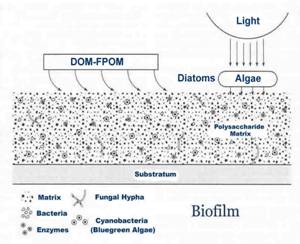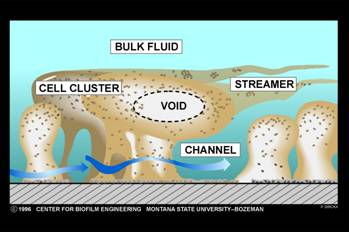Early Views of the Nature of Biofilms
Henrici and Zobell, Bacteria on surfaces and the Bottle effect
Since the pioneering investigations of Robert Koch (1843 - 1910) microbiologists have been investigating bacteria almost exclusively in single species planktonic culture. This pure culture paradigm became so ingrained in universities and medical schools that the idea arose that, "if you were not doing pure culture microbiology, you weren't doing science. The pure culture approach was, without question, enormously successful, affirming the wisdom of Koch and his contemporaries and leading to a "Golden Age" of microbiology in which the agents of many devastating human pathogens, including tuberculosis, cholera and diphtheria, were identified and largely conquered. Unfortunately this concentration on planktonic pure cultures led microbiologists away from the study of bacteria as they exist in nature. It was not until the early 20th century that some microbiologists began to feel that this view of bacteria was inadequate to describe bacterial life styles not to mention microbial interactions. Henrici wrote, "It is quite evident that for the most part the water bacteria are not free floating organisms, but grow on submerged surfaces; they are of the benthos rather than the plancton."(Henrici 1933).
A decade later Zobell reported on his glass bottle experiments in which bacteria introduced into a bottle disappear from the liquid phase. Simultaneously there was a rapid increase in the number of bacteria attached to the surface of the bottles. This bacterial adhesion was accompanied by an increase in the amount of suspended organic material. Zobell concluded that the bacteria attached themselves to the glass surface where they encountered a concentration of organic nutrients much higher than would have been found in the bulk fluid (Zobell 1943).
In the ensuing decades, microbiologists described many examples of microbe/eucaryote interactions of an astonishing variety. Some were mutualistic (Legume/Rhizobium nitrogen fixing associations, ruminant/microbe associations, Vibrio fischeri in the light organs of bioluminescent squid and fish) and others were pathogenic (Pseudomonas in the lungs of cystic fibrosis patients, Staphylococcus species in sinusitis and otitis media). One thing most had in common was that the microbial component of the association was found to be in direct physical contact with the tissues of the host plant or animal. These and other discoveries caused many microbiologists to grow uneasy about the idea that many or most bacteria live in the planktonic life style.
Today we have ample justification for their concern. Investigations of natural habitats (Geesey 1977) and human influenced ones verify that most, greater than 99%, of the resident bacteria are attached to surfaces and the ratio of sessile to planktonic bacteria is often greater than 1000-10,000:1.
In the awakening era of biofilm investigation, that is in the 1970s and 80s, it was thought that bacteria growing on surfaces formed flat, uniform, and dull layers of cells covered and surrounded by slime. If our view was flat and boring, it wasn’t necessary to think much beyond a big colony growing on an agar plate. But the earliest confocal images with towers, mushrooms and evidence of channels deep within the biofilm mass radically changed our view. In this view, cells do not simply pile one on top of the other but rather they form structures of astonishing complexity. This complex architecture demands regulation and control and an entirely new way of looking at biofilm growth and development.
Early Views of Biofilm Structure - Caldwell and Costerton

This more contemporary view shows features of biofilm architecture unsuspected with earlier technology, particularly the vertical structural elements (towers and mushrooms) and the water channels which deliver bulk fluid and nutrients deep into the biofilm.

In biology, as in all science, what we can see is determined by what our instruments and techniques will permit us to see. Seventeenth century astronomers believed that all celestial objects were perfect and perfectly round. When viewing the sun or moon with the naked eye this is not an unreasonable conclusion. It wasn't until Galileo observed the moon and sun with his primitive telescope that he concluded there were irregularities such as craters and sunspots in these "perfect spheres".
